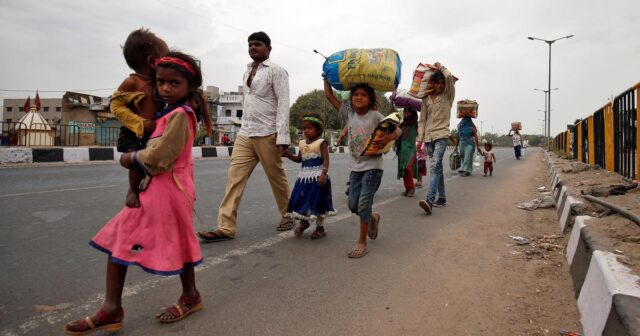We’ve all seen the distressing visuals of migrant workers walking, cycling and dragging themselves to get to their hometowns, hundreds of kilometres away from the cities they called home for a while.
For a majority of them, it seems that the cities have suddenly abandoned them in the time of need and with no food, no jobs and no shelter in sight. Millions have set forth on a long journey in search of familiar faces.

The migrant crisis, as it unfolds before our eyes, has always been brewing on the sidelines. A pandemic has finally caused the bubble to burst, leaving behind death and pain.
But the question comes to mind, what rights did the migrant workers actually have under normal circumstances?
Responsibility Of The Central Govt Or The States?
According to the seventh schedule’s union list, “Inter-state migration; inter-State quarantine” falls under the power of the parliament. The central government is responsible for the millions who are travelling across state borders right now.
However, according to the concurrent list, matters of “Trade unions; industrial and labour disputes” are to be shared by both the state and the union government. This makes sense because the large workforce of migrants helps the economies of both their home state and their host states.
However, most states have seemingly given up on taking charge of the migrants.
No Database
There is no comprehensive database of the large inter and intrastate migrant population. According to the Sengupta committee report, nearly 65% of the migrants work in the agricultural sector.
Most are engaged in the informal sector, without proper documentation and job security, leaving them vulnerable to disasters such as the coronavirus pandemic.
To make it even worse, ration cards, which help provide food at subsidized rates are only applicable in one’s hometown, not at the workplace. This leaves a poor worker at the mercy of their employer, and thus, is forced to spend more on basic utilities.
Inter-State Migrant Workmen Act, 1979
The Inter-State Migrant Workmen Act, 1979, (ISMWA), was enacted to protect the rights of interstate labourers. However, this law is not inclusive of local labourers.
The Act has been considered to be the least implemented piece of legislature, even before the current migrant crisis, leaving migrants to largely fend for themselves.
Under ISMWA, a worker is considered to be a migrant worker only if they migrate through a contractor. The outdated law has been criticized by policymakers for years now as most workers work in the informal sector with no contracts and thus no social security.
Also Read: Indore Police Sets Up Carts Giving Away Free Footwear To Bare-Foot Migrants Walking To Their Villages
Labour Law Relaxations
As a response to the coronavirus outbreak in India, Uttar Pradesh made the questionable decision of suspending most labour laws for the next 3 years.
States like Madhya Pradesh, Gujrat and Rajasthan have also taken to amending their labour laws- in a bid to making it easier to hire and fire a worker, increase working hours, and making it easier for contractors to employ a certain number of workers without registration.
All these moves are further destroying the already vulnerable situation of the migrant workers.
What’s Being Done For Them Now
Fund allocation for MGNREGA has been increased by ₹40,000 and returning migrant workers would be enrolled in the MGNREGA scheme in a bid to assure employment till the monsoon season. Along with this, states are now allowed to use State Disaster Response Fund to provide food and shelter to migrant workers.
The migrant workers will be provided with food grains for two months without the need for ration cards. Additionally, ‘One Nation One Card’ scheme was announced by the FM Nirmala Sitharaman to make access to food easier.
Under Pradhan Mantri Awash Yojana (PMAY), housing support will be provided to the urban migrant labourers by helping them get concessions on rent.
Special Shramik trains were deployed to make the transportation of migrants easier, however, reports of nearly 80 people dying on these trains in one month alone has invited criticism.
Employment drives for migrants have already begun with real estate body National Real Estate Development Council (NAREDCO) set to provide 2.5 lakh migrant workers in UP who returned to the state due to the coronavirus pandemic.
Civil society has been constantly working with NGOs by volunteering and donating, but to effectively manage the migrant crisis, the central government must step up its efforts to provide relief to the long-suffering migrant workers.
Image Credits: Google Images
Sources: Indian Express, The Hindu, NY Times
Find the Blogger: @RoshniKahaHain
This post is tagged under: migrant crisis, central government, state governments, rights, laws, acts, protection, relief, what is being done for them, how to solve the migration crisis, what rights do migrants have
Other Recommendations:
This Video Shows How Privileged We Are And How Disadvantaged Migrants Are